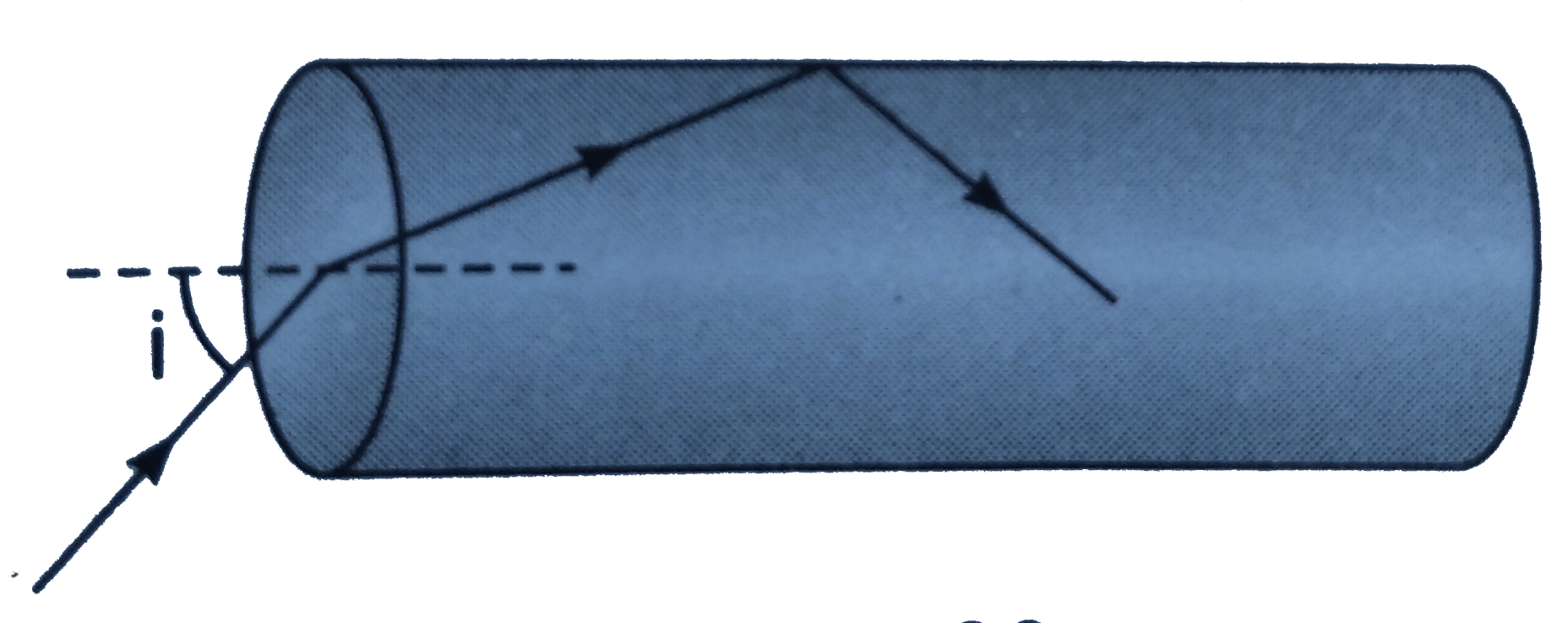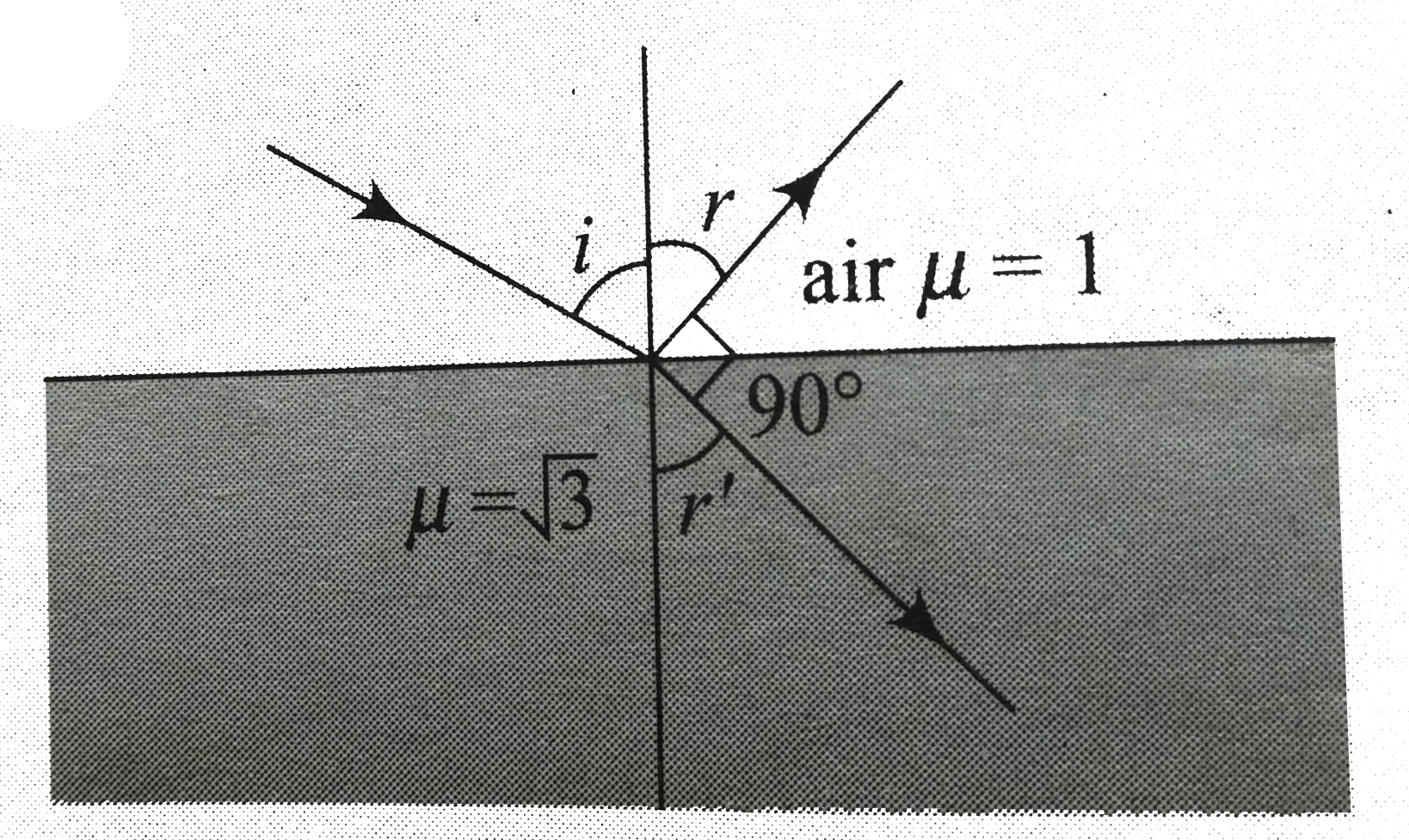Light enters at an angle of incidence in a transparent rod of refractive index n. For what value of the refractive index of the material of the rod the light once entered into it will not leave it through its lateral face whatsoever be the value of angle of incidence.
n>√2
n=1
n=1.1
n=1.3
The correct Answer is:A
To solve the problem of determining the refractive index n of a transparent rod such that light entering it will not exit through its lateral face, we will follow these steps:
Step 1: Understanding Total Internal Reflection
When light travels from a medium with a higher refractive index to a lower refractive index, it can undergo total internal reflection if the angle of incidence exceeds a certain critical angle. For light to not exit through the lateral face of the rod, we need to ensure that total internal reflection occurs at that interface.
Step 2: Define the Critical Angle
The critical angle θC can be defined using Snell's Law:
n1sinθC=n2sin90∘
Where:
- n1 is the refractive index of the rod (which we denote as n),
- n2 is the refractive index of air (which is approximately 1),
- θC is the critical angle.
Since sin90∘=1, we can simplify this to:
nsinθC=1
Step 3: Rearranging for Critical Angle
From the above equation, we can express the critical angle as:
sinθC=1n
Step 4: Condition for Total Internal Reflection
For total internal reflection to occur at the lateral face (let's denote this face as BC), the angle of incidence must be greater than the critical angle:
θ>θC
Step 5: Finding the Minimum Refractive Index
To ensure that light does not exit through the lateral face regardless of the angle of incidence, we can assume the maximum angle of incidence is 90∘. In this case, the critical angle must be 90∘ or less. Therefore, we set:
θC=90∘
This leads us to the condition:
sinθC=1⟹1n=1⟹n≥√2
Step 6: Conclusion
Thus, for the light to not exit through the lateral face of the rod, the refractive index n of the material of the rod must be greater than √2.
Final Answer
The value of the refractive index n must be greater than √2.
---
When light travels from a medium with a higher refractive index to a lower refractive index, it can undergo total internal reflection if the angle of incidence exceeds a certain critical angle. For light to not exit through the lateral face of the rod, we need to ensure that total internal reflection occurs at that interface.
The critical angle θC can be defined using Snell's Law:
n1sinθC=n2sin90∘
Where:
- n1 is the refractive index of the rod (which we denote as n),
- n2 is the refractive index of air (which is approximately 1),
- θC is the critical angle.
nsinθC=1
From the above equation, we can express the critical angle as:
sinθC=1n
For total internal reflection to occur at the lateral face (let's denote this face as BC), the angle of incidence must be greater than the critical angle:
θ>θC
To ensure that light does not exit through the lateral face regardless of the angle of incidence, we can assume the maximum angle of incidence is 90∘. In this case, the critical angle must be 90∘ or less. Therefore, we set:
θC=90∘
sinθC=1⟹1n=1⟹n≥√2
Thus, for the light to not exit through the lateral face of the rod, the refractive index n of the material of the rod must be greater than √2.
The value of the refractive index n must be greater than √2.
Topper's Solved these Questions
- BOOK - CENGAGE PHYSICS ENGLISHCHAPTER - RAY OPTICSEXERCISE - DPP 1.314videos
RAY OPTICS
- BOOK - CENGAGE PHYSICS ENGLISHCHAPTER - RAY OPTICSEXERCISE - DPP 1.415videos
RAY OPTICS
- BOOK - CENGAGE PHYSICS ENGLISHCHAPTER - RAY OPTICSEXERCISE - Matching Column Type1videos
RAY OPTICS
- BOOK - CENGAGE PHYSICS ENGLISHCHAPTER - PHOTOELECTRIC EFFECTEXERCISE - Integer Type4videos
PHOTOELECTRIC EFFECT
- BOOK - CENGAGE PHYSICS ENGLISHCHAPTER - SOURCES OF MAGNETIC FIELDEXERCISE - single correct Ansewer type12videos
SOURCES OF MAGNETIC FIELD
Similar Questions
When a ray of light is incident normally on one refracting surface of an equilateral prism (Refractive index of the material of the prism =1.5
View SolutionLight is incident at an angle i on one planer end of a transparent cylinderical rod of refractive index μ. Find the least value of μ so that the light entering the rod does not emerge from the curved surface of the rod irrespective of the value of i.
 View Solution
View SolutionWhen a ray of light is incident normally on one refracting surface of an equilateral prism (Refractive index of the material of the prism =1.5)
View SolutionA light of wavelength fall on a plane surface at an angle of incidence 53. The refractive index of surface material, if the reflected light is completely plane polarised is
View SolutionThe refractive index of the material of a prism is 1.5 and its refracting angle is 6º. Find the deviation produced by the prism for a small angle of incidence.
View SolutionThe refractive index of the material of a prism is 1.5 and its refracting angle is 6º. Find the deviation produced by the prism for a small angle of incidence.
View SolutionA ray of light incident at an angle 90° with the face of an equilateral prism passes symmetrically. Calculate the refractive index of the material of the prism
View SolutionA ray of light is incident on a glass sphere of refractive index 3/2. What should be the angle of incidence so that the ray which enters the sphere does not come out of the sphere ?
View SolutionWhen light rays are incident on a prism at an angle of 45∘, the minimum deviation is obtained. If refractive index of the material of prism is √2, then the angle of prism will be
View SolutionA ray of light is incident on a transparent glass slab of refractive index √3. If the reflected and refracted rays are mutually perpendicular, what is the angle of incidence?
 View Solution
View Solution

